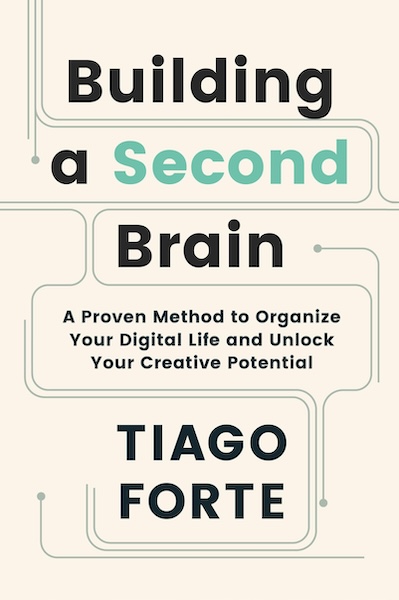Tiago Forte - Building a Second Brain

My rating: ★★★★☆ (90%)
This book changed the way I think about note-taking. I can’t recommend it enough. In this review, I’ll explain the book’s main two ideas.
TL;DR
- Zettlekasten makes you spend too much energy upfront when consuming content. The second brain method lets you spend that energy later and only if needed. Putting verbatim highlights in your notes is fine.
- Organise your notes into a structure that reflects how useful the note is to you now (PARA).
The Zettelkasten Method: Perfectionism and Upfront Effort
In software, there is a concept of iteration, which delays all decisions until later and works only at the absolute minimum to deliver value. In other words, don’t do the work before it’s necessary.
I use this approach when writing software all day, every day. However, somehow, I didn’t do that when taking notes. I encountered the zettelkasten school of thought first, and since then, I have spent obscene amounts of time juicing out all the information from every book I’ve read.
Since I started with Slip-box, I felt that it takes too much time to write good notes. It takes me roughly half an hour to produce one permanent note (including the time for reading). For example, when I read Software Engineering at Google it took me three hours to read a chapter and make five permanent notes. I’m comforting myself that now that I put effort to extract the knowledge and linking it with my existing notes, I’ll always have it readily available. But was it worth three hours of my time?
- My quote from Zettelkasten note-taking after one year
I thought note-taking should take a long time. Watching videos of “professional” zettelkasten note-takers, I saw that it’s normal.
The Second Brain Method: Deferring Effort and Organizing with PARA
After reading Tiago’s book, I realised I was doing it wrong. My perspective on note-taking was turned on its head for four years.
The following table sums up the difference:
| zettlekasten | second brain | |
|---|---|---|
| Note quality | Each note is a well-described idea linked to the network of other ideas. If this idea conflicts with a pre-existing idea, the conflict must be resolved | The note can be anything, a set of highlights, a paragraph, or a picture. You can copy-paste interesting parts of an article and not post-process it 🤯 |
| notes organisation | network of interlinked notes (think Wikipedia) | folder structure based on your work and interests |
| most of the work happens | when you create the note | when you need to use the note |
The Zettlekasten method always seemed perfectionist to me, but the only alternative I knew of was to write the notes as I used to before, write notes as I read a book, and never return to them again. Also, the idea of perfected notes (almost like small blog posts) that are little atoms of knowledge was very seductive.
However, putting that much effort into note-taking is not worth it for most topics. Maybe when I read a well-written, short book about the exact topic that’s key for my current project, I can process it in that much detail, but when I casually read Thinking Fast and Slow, I shouldn’t put in that much effort because I’m not sure I’ll need that information.
That’s when Tiago’s second brain comes in. You defer polishing/organising the notes until you need them. You take raw notes with any interesting information, and you organise them using the PARA method.
The PARA method lets you organise your notes by “how useful they are to you”. The more useful they are, the more prominent they get in your note structure.
PARA stands for:
- Projects: This is a folder with all your current initiatives, both work and life. (Examples: Renovate kitchen, write a blog post about mountain bikes)
- Areas: Your areas of responsibility. Projects usually last for a short while, while Areas last much longer. (Examples: parenting, leadership, health)
- Resources: These are any other useful notes that don’t belong to the previous two.
- Archive: Everything you stop being interested in, you move to the archive.
You can google “PARA method” for a more detailed explanation.
Personal Experience: Enjoying Reading More with the Second Brain Method
Since I implemented this method, I’ve enjoyed reading much more. Since I’m now “allowed” to copy and paste my highlights and be done with the note, I started using Omnivore as a read-later app, and I’m making more careful highlights in my KOReader.
I now read at different levels of attentiveness. I can pretty much guess which PARA folder the note will go into, and based on that, I either read for leisure (when I know it will go to “Resources”) or read carefully (if the content applies to one of my projects).
At work, the PARA method helps me have a clear overview of my current responsibilities. Recently, I had to go on sick leave, and I could take a snapshot of my work project notes and use that as a clear status update for my colleagues.
It’s been only a month since I read the book so portion of my sentiment can be attributed to “new and shiny” factor, however I’m quite optimistic about this drastic shift in my note-taking.
Summary
- Zettlekasten method requires a large amount of work when reading new material. In my opinion, it’s a method designed for academics to read papers in their field.
- Second brain provides two ideas (delayed effort, PARA) to make taking notes easy and delaying all the work to when you use the notes
- My personal experience makes me think that a Second brain is much better for non-academics.